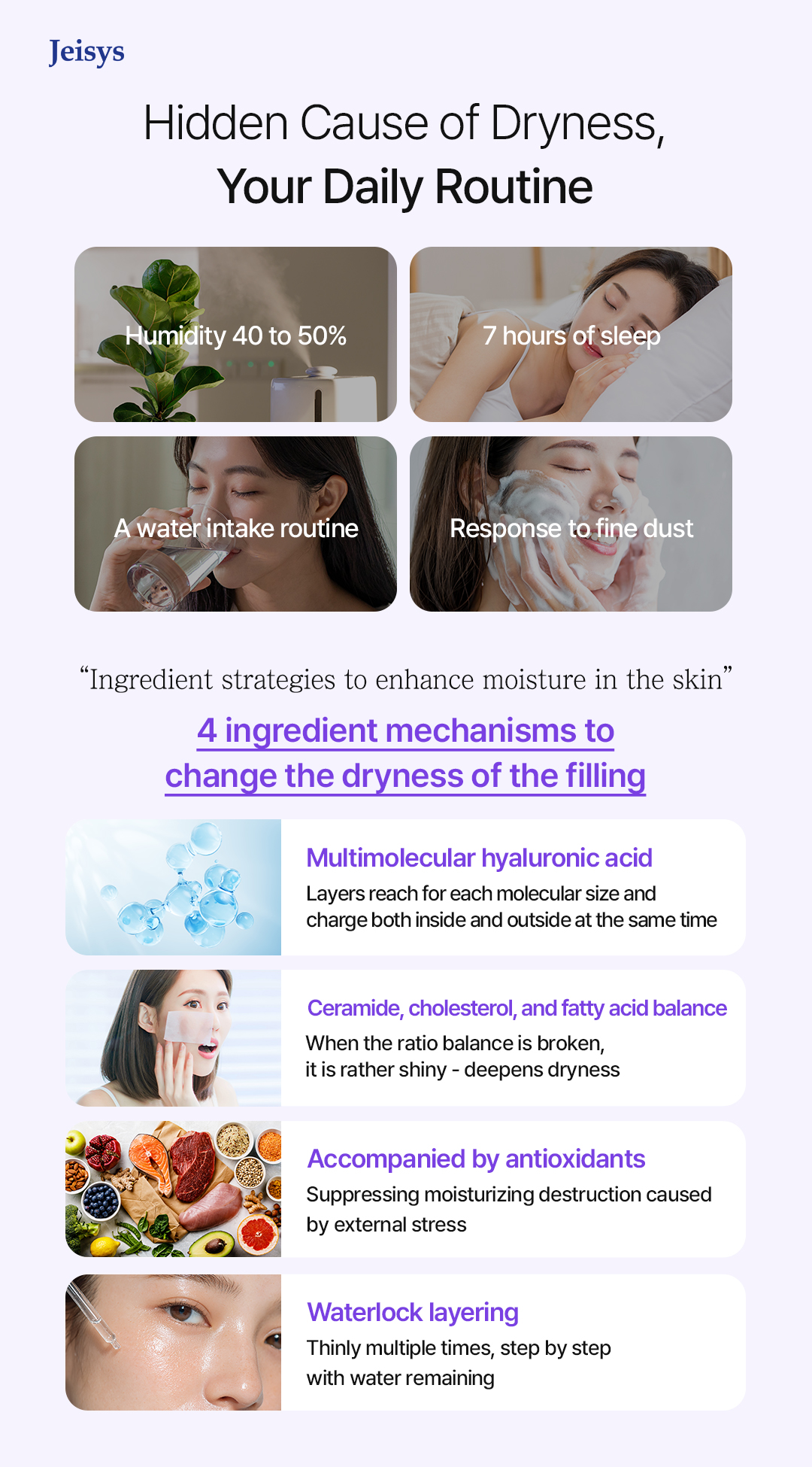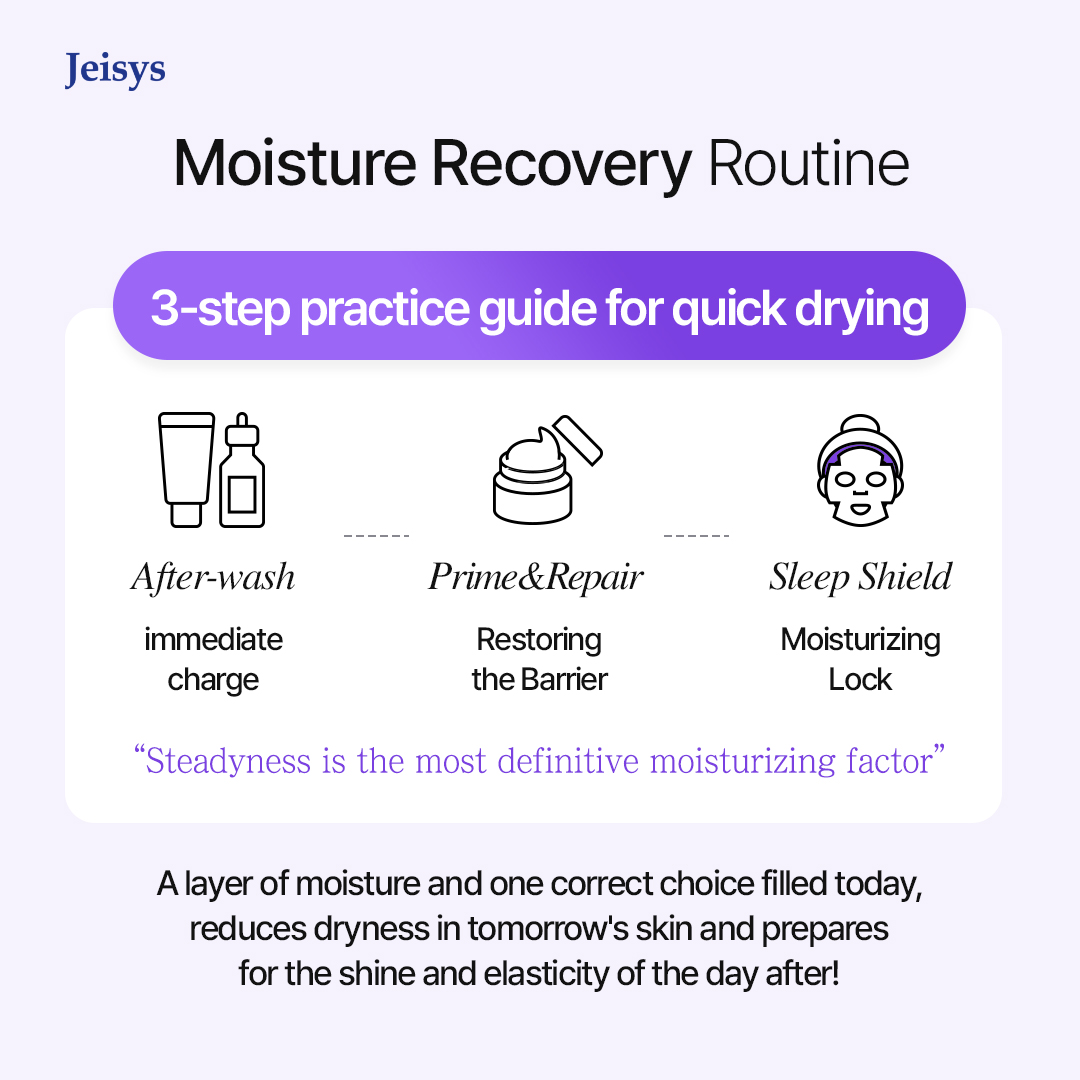- Author
- Date
- 2025-11-17
- Views
- 181

When the cold wind begins to blow, the skin is the first to sense the change.
If dryness persists no matter how much cream you apply, the problem is not on the ‘surface’ but Inner Skin Dryness (Dermal Dryness).
When the reservoir in the stratum corneum empties and the barrier loosens, a dual state appears: the inside is parched, but the outside is only oily.
Now, Skin Moisture Management must expand beyond simple topical moisturizing to building a system where the skin can autonomously store, maintain, and restore moisture.
Table of Contents
- Trend 1. The Science of Skin Dryness – Why does ‘Inner Dryness’ occur?
- Trend 2. Cleansing Methods that Deprive Skin of Moisture
- Trend 3. The Hidden Cause of Inner Dryness: Your Daily Routine
- Trend 4. Ingredient Strategies to Enhance Internal Skin Hydration
- Trend 5. Moisture Recovery Routine

Trend 1. The Science of Skin Dryness – Why does ‘Inner Dryness’ occur?
Inner dryness is not a lack of moisture itself, but a ‘reduction in moisture retention capacity’.
When the lipids (Ceramides, Cholesterol, Fatty Acids) that fill the gaps between the stratum corneum collapse, moisture rapidly evaporates through the tiny gaps.
When UV rays, fine dust, and sudden changes in temperature/humidity increase free radicals, causing repeated micro-inflammation,
the collagen network in the dermis loosens, and the structural foundation for holding moisture weakens.
Causes of Inner Skin Dryness
① Barrier-Dermis Interdependence: A weakened barrier leads to concurrent dermal moisture loss → Inner Skin Dryness where the surface remains oily while the inside is dry.
② Time-lagged Dryness: The skin feels dewy immediately after cleansing but rapidly tightens hours later → A sign of NMF (Natural Moisturizing Factor) depletion.
③ Thermal Aging: Exposure to heating and heat-generating devices raises epidermal temperature, accelerating evaporation → Long-term decrease in Skin Moisture Management efficiency.
Trend 2. Cleansing Methods that Deprive Skin of Moisture
Obsessive double/triple cleansing, frequent scrubbing, and hot water cleansing wash away barrier lipids, cementing inner dryness.
Wiping roughly with a towel or delaying moisturizer application long after cleansing are also problematic.
Cleansing should be completed with a low-irritation, slightly acidic cleanser once, finished briefly with lukewarm water, and primary moisturizing should be applied immediately while the skin is still damp to block the evaporation pathway first.
Checklist
① “3-Minute Rule After Cleansing”: Layer a hydrating serum, then seal with cream.
② Minimize Friction: Use a pressing/patting method to absorb, rather than rubbing.
③ Separate Night Routine: Reduce exfoliation frequency and focus on recovery ingredients at night (barrier, soothing, moisture-centric).
→ Just changing these basics significantly reduces tightness, flakiness, and makeup pilling caused by Inner Skin Dryness.

Trend 3. The Hidden Cause of Inner Dryness: Your Daily Routine
The living environment dictates the success or failure of Skin Moisture Management.
If indoor humidity drops below 40% due to heating, moisture in the stratum corneum is rapidly lost.
Lack of sleep disrupts the nocturnal regeneration rhythm due to decreased melatonin secretion.
Excessive caffeine/sugar, irregular meals, and prolonged digital exposure also increase micro-inflammation, worsening inner dryness.
Life Rituals that Reduce Inner Dryness
① Humidity 40~50%: Environmental correction using humidifiers, wet towels, or aquatic foliage plants.
② 7 Hours of Sleep: A moisturizing and barrier routine aligned with the regeneration golden time (10 PM to 2 AM) accelerates Inner Skin Dryness recovery.
③ Hydration Intake Routine: Consuming water, electrolytes, and hydrating vegetables in split amounts stabilizes internal moisture circulation (split intake is better than sudden large amounts).
④ Fine Dust Countermeasures: Low-irritation cleansing immediately upon returning home → Barrier and antioxidant care to block oxidative stress.
As the management of environment, sleep, intake, and exposure accumulates, skin elasticity also naturally tends to recover.
Trend 4. Ingredient Strategies to Enhance Internal Skin Hydration
The core of Skin Moisture Management is the division of roles: “Attract – Retain – Soothe”.
Humectants like Hyaluronic Acid and Glycerin attract water, while Ceramides, Cholesterol, and Fatty Acids seal leakage pathways by retaining moisture.
Panthenol and Allantoin help relieve irritation and restore the barrier, and the microbiome/prebiotics stabilize the skin surface ecosystem, extending the duration of hydration.
4 Ingredient Mechanisms to Combat Inner Dryness
① Multi-molecular Hyaluronic Acid: Reaches different layers based on molecular size, simultaneously recharging inner and outer skin (reduces inner tightness).
② Ceramide-Cholesterol-Fatty Acid Balance: If the ratio is unbalanced, it worsens the oily surface/dry interior phenomenon.
③ Antioxidant Support: Vitamins C, E, Coenzyme Q10, etc., suppress moisture breakdown caused by external stress, extending the recurrence interval of Inner Skin Dryness.
④ Water-Lock Layering: Apply thinly multiple times, layering products step-by-step while the skin is still damp → Simultaneous increase in perceived moisturization and skin elasticity.

Trend 5. Moisture Recovery Routine
Recovery does not happen in a day.
If the essence of inner dryness is “reduction in storage, maintenance, and restoration capacity”, the routine must also repeat the cycle of “Charge – Restore – Lock” daily.
This process is not simple moisturizing but **“Self-Regenerative Training”** to teach the skin to manage its own moisture.
3-Step Practical Guide for Inner Skin Dryness
1) Immediate Charge (After-wash)
Immediately after cleansing, balance pH with toner and layer a hydrating essence 2-3 times. Apply while slightly damp to encourage humectants to actively capture water. Layering at this stage determines the perceived efficacy of Skin Moisture Management.
2) Barrier Restoration (Prime & Repair)
During the cream step, use a combination of ceramide, cholesterol, and fatty acids to fill micro-fissures and block leakage pathways. Instead of excessive exfoliation, establishing soothing and restoration first with panthenol and centella ingredients calms the flakiness and scaling caused by Inner Skin Dryness, favoring surface texture refinement and maintaining Skin Elasticity.
3) Moisture Lock (Sleep Shield)
At night, form an evaporation barrier with a sleeping mask or oil mist. Since absorption increases as body temperature rises during sleep, applying a thin layer and pressing it in firmly reduces morning tightness and brings out a healthy glow. An additional practical tip for extending the duration of Skin Moisture Management is to aid microcirculation 2-3 times a week with roller or alternating hot & cool massage.
Consistency is the most reliable form of moisturization!
Inner dryness is not temporary dehydration but a systemic problem involving lifestyle, environment, barrier, and dermis.
Therefore, the solution must also be systemic.
Maintaining a consistent routine—Environmental correction (humidity/temperature) → Minimal cleansing → Water-lock layering → Barrier restoration → Nighttime lock—reduces morning tightness and maintains hydration and Skin Elasticity until evening.
Your skin remembers your habits.
The layer of moisture applied today and the correct choices made prepare your skin to reduce Inner Skin Dryness tomorrow and enhance its glow and elasticity the day after.
Consistency is the most reliable form of moisturization.


